What is Cashew Shelling? Manual Shelling & Machine Shelling Methods

Mục lục
Cashew nuts are a delicious and nutritious food that is loved by many consumers because of their delicious, rich, and fatty taste. However, cashew nuts have a rather hard shell and are difficult to peel, so many people are "afraid" to buy fresh cashew nuts for processing. Follow our article below to learn how to peel cashew nuts quickly and effectively!
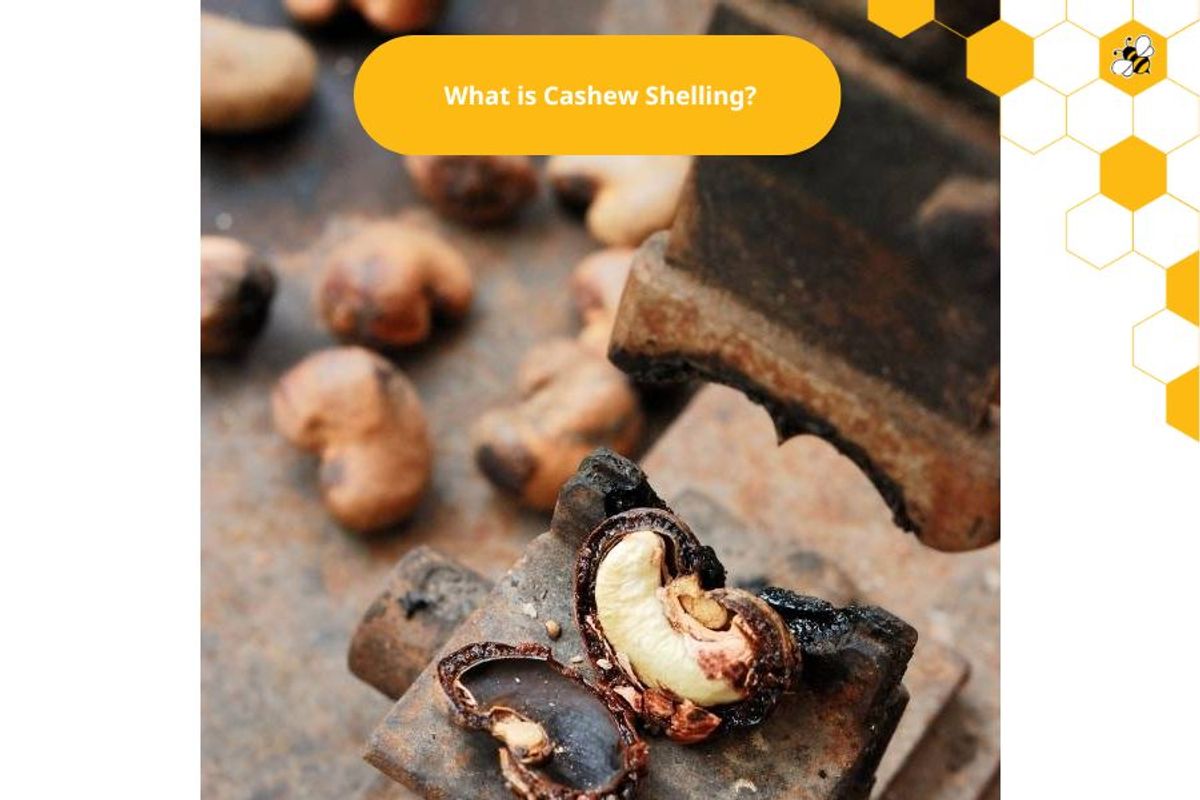
What is cashew shelling?
Cashew shelling is the process of removing the outer shell of the cashew nut to get to the kernel inside. Cashew nuts have two shells: the outer shell (silk shell) and the hard shell inside. When harvested, cashew nuts usually have the silk shell attached tightly, and to use cashew nuts, they need to be peeled.
There are two common methods for peeling cashew nuts:
There are two common methods for peeling cashew nuts:
Manual peeling (hand peeling)
This method uses hands or a rudimentary razor to peel the silk shell outside the cashew nut.
Requires the peeler to be meticulous and skillful, preventing the knife from penetrating the cashew nut.
Advantages: No need to invest in machinery, suitable for small-scale production.
Disadvantages: Low labor productivity and high loss rate.
Requires the peeler to be meticulous and skillful, preventing the knife from penetrating the cashew nut.
Advantages: No need to invest in machinery, suitable for small-scale production.
Disadvantages: Low labor productivity and high loss rate.
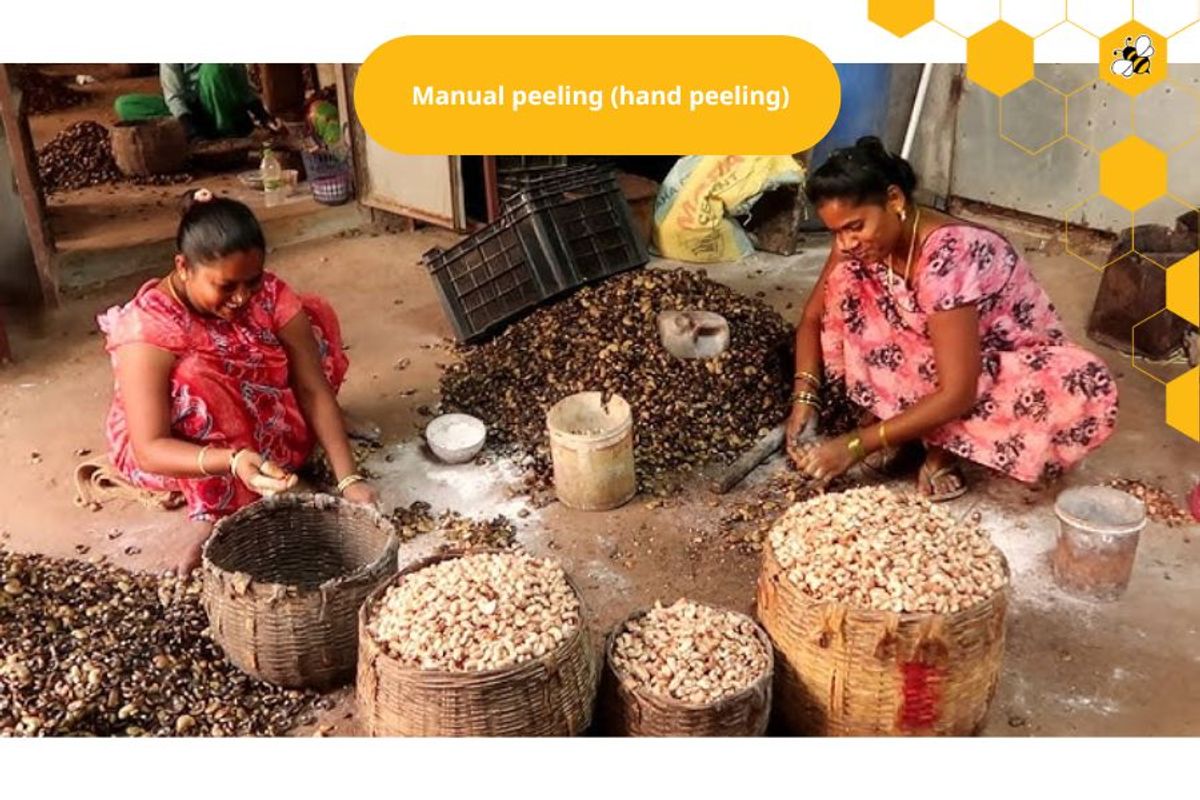
Mechanical peeling (by machine)
Using a machine to peel the shell with an operating mechanism based on mechanical rubbing or compressed air.
Higher efficiency than manual peeling, but requires investment in machinery.
Since 2009, Vietnam has developed an automatic peeling machine system, creating an advantage for the cashew processing industry.
Higher efficiency than manual peeling, but requires investment in machinery.
Since 2009, Vietnam has developed an automatic peeling machine system, creating an advantage for the cashew processing industry.
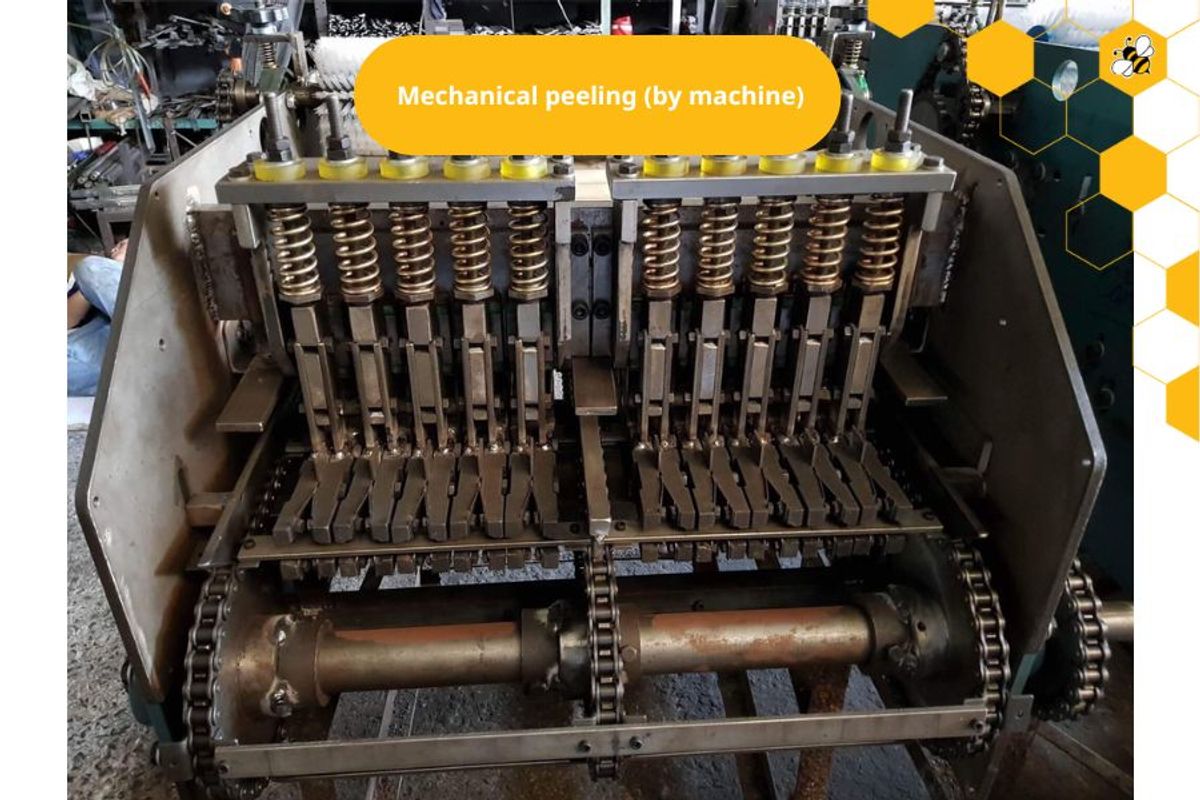
Technical requirements
Skin peeling is an important step in the cashew processing process. The skin peeling technique requires meticulousness and skill to obtain the most effective cashew kernels.
After the hard outer shell is removed, the cashew kernels still have a thin brown skin covering the outer kernel.
After the cashew kernels (with skin) have been dried to the required standard, they will be transferred to the skin peeling department to remove the skin and remove the kernels.
Here are the technical requirements to follow when peeling the skin:
The cashew kernels must be completely clean of the skin: There must be no remaining skin on the surface of the cashew kernels. This ensures that the cashew kernels are not dirty and retain their natural sweetness, richness, and fat.
The cashew kernels must be intact: They must not be broken and the shaving must not exceed the allowable level. This ensures product quality and preserves the nutritional value of the cashew kernels.
After the hard outer shell is removed, the cashew kernels still have a thin brown skin covering the outer kernel.
After the cashew kernels (with skin) have been dried to the required standard, they will be transferred to the skin peeling department to remove the skin and remove the kernels.
Here are the technical requirements to follow when peeling the skin:
The cashew kernels must be completely clean of the skin: There must be no remaining skin on the surface of the cashew kernels. This ensures that the cashew kernels are not dirty and retain their natural sweetness, richness, and fat.
The cashew kernels must be intact: They must not be broken and the shaving must not exceed the allowable level. This ensures product quality and preserves the nutritional value of the cashew kernels.
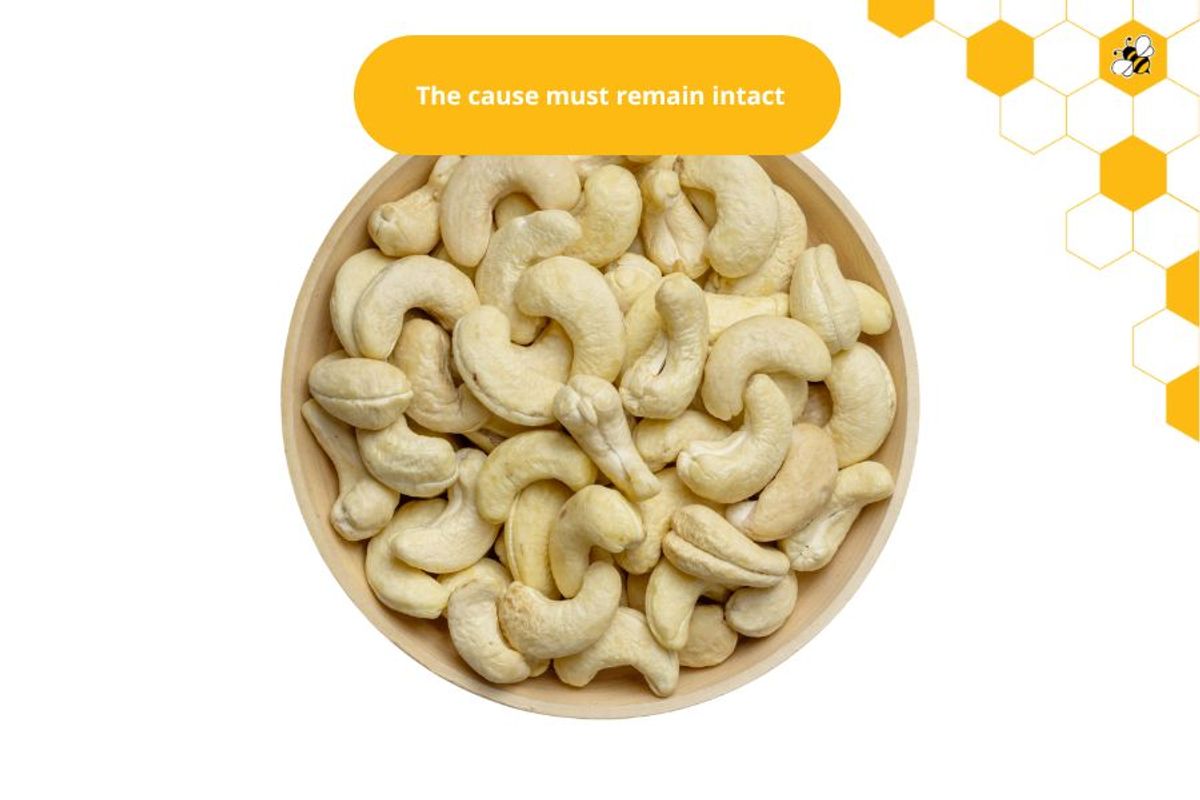
Manual shelling method
Manual shelling is a method of using hands or a rudimentary razor to peel off the outer shell of the cashew nut. This method requires the peeler to be meticulous and skillful, preventing the knife from penetrating the cashew nut, and causing the shell to be peeled or broken. Below are detailed instructions on how to manually shell cashew nuts:
Wear gloves: Before peeling the cashew nut, wear gloves to avoid the cashew nut resin from sticking to your hands. This resin contains toxins that can damage the skin. You can choose nylon or rubber gloves to ensure safety.
Wear long-sleeved shirts: When peeling cashew nuts, you should wear long-sleeved shirts to protect your hands. A closed-neck shirt also helps prevent the cashew nut resin from sticking to your skin and causing itching or scarring.
Wear goggles: If you want to be more careful, wear goggles to protect your eyes. Cashew nut resin can splash into your eyes and cause danger.
How to peel cashew nuts manually:
Hold the cashew nut firmly with your left hand: Place the cashew nut in the palm of your left hand.
Positioning the cashew nut: The belly of the cashew nut will face your eyes, while the back will face down.
Gently press the pedal with your left foot: When you lightly press the pedal with your left foot, the cashew nut will be peeled.
Continue to press the pedal with your right foot to tilt the cashew nut peeler: Use your right foot to press the pedal, causing the cashew nut peeler to tilt and peel the silk shell.
Use a pry knife to remove the cut cashew kernel: Use a pry knife to remove the cut cashew kernel from the silk shell.
Advantages of manual silk peeling:
No need to invest in machinery: Manual silk peeling does not require investment in machinery and equipment, so the investment cost is low. Mainly need to use a peeling table and a razor to do it.
Peeling of seeds with rough, hard-to-peel shells: Manual peeling can handle rough, hard-to-peel shells that peeling machines cannot do.
Disadvantages of manual peeling:
Low labor productivity: On average, a person can only peel about 7 to 10 kg per day, so it requires a lot of labor and is difficult to expand production scale.
High loss rate: The rate of broken kernels is uneven and depends a lot on the skill of the worker.
Wear gloves: Before peeling the cashew nut, wear gloves to avoid the cashew nut resin from sticking to your hands. This resin contains toxins that can damage the skin. You can choose nylon or rubber gloves to ensure safety.
Wear long-sleeved shirts: When peeling cashew nuts, you should wear long-sleeved shirts to protect your hands. A closed-neck shirt also helps prevent the cashew nut resin from sticking to your skin and causing itching or scarring.
Wear goggles: If you want to be more careful, wear goggles to protect your eyes. Cashew nut resin can splash into your eyes and cause danger.
How to peel cashew nuts manually:
Hold the cashew nut firmly with your left hand: Place the cashew nut in the palm of your left hand.
Positioning the cashew nut: The belly of the cashew nut will face your eyes, while the back will face down.
Gently press the pedal with your left foot: When you lightly press the pedal with your left foot, the cashew nut will be peeled.
Continue to press the pedal with your right foot to tilt the cashew nut peeler: Use your right foot to press the pedal, causing the cashew nut peeler to tilt and peel the silk shell.
Use a pry knife to remove the cut cashew kernel: Use a pry knife to remove the cut cashew kernel from the silk shell.
Advantages of manual silk peeling:
No need to invest in machinery: Manual silk peeling does not require investment in machinery and equipment, so the investment cost is low. Mainly need to use a peeling table and a razor to do it.
Peeling of seeds with rough, hard-to-peel shells: Manual peeling can handle rough, hard-to-peel shells that peeling machines cannot do.
Disadvantages of manual peeling:
Low labor productivity: On average, a person can only peel about 7 to 10 kg per day, so it requires a lot of labor and is difficult to expand production scale.
High loss rate: The rate of broken kernels is uneven and depends a lot on the skill of the worker.
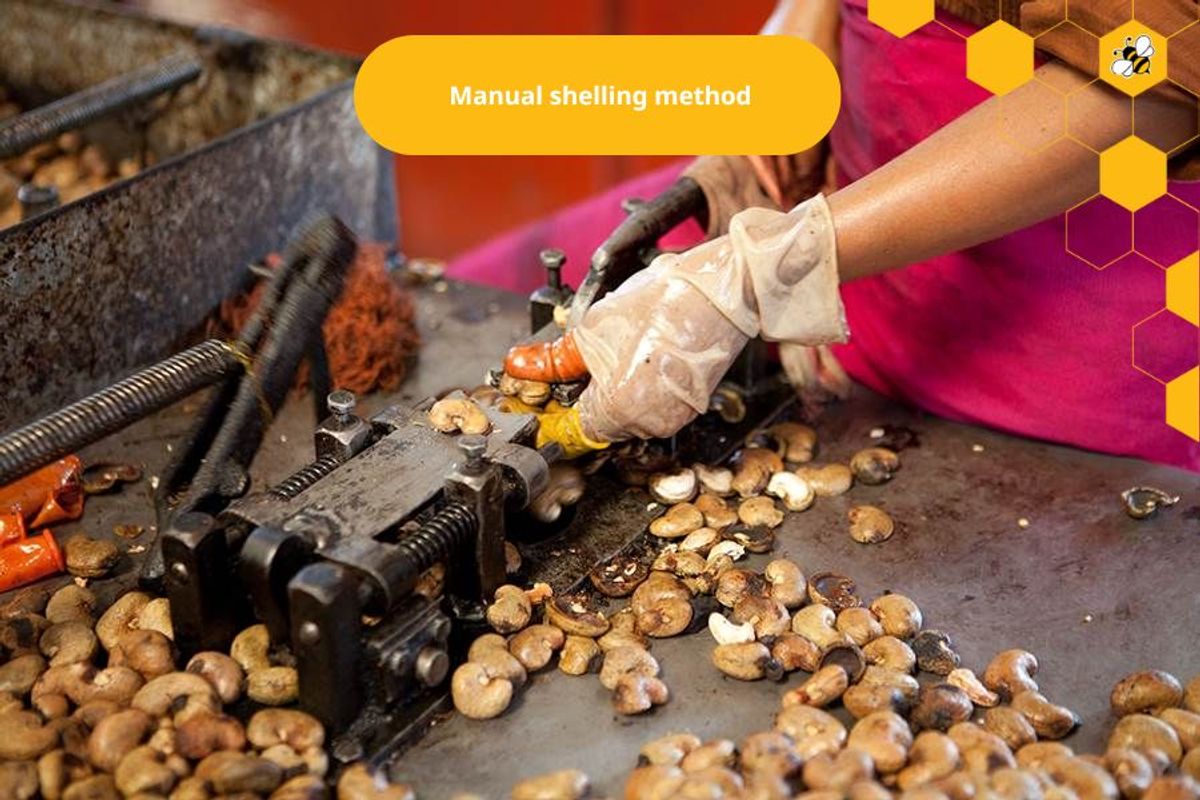
In addition, you can also use a specialized machine to peel the cashew nut shell. This machine will automatically perform the peeling process, saving time and effort.
Machine peeling method
To peel the cashew nut shell by machine, there are several different methods and processes. Some detailed instructions:
Use a machine to peel the shell with a mechanism based on mechanical rubbing or using compressed air to blow the shell off the cashew nut.
The automatic shelling machine puts the cashew nut through the automatic shelling system, the output is the cashew nut that has been blown clean of the shell, and the shell is blown separately from the nut.
September the cashew nut shell by hand combined with a specialized machine:
Hold the cashew nut firmly with your left hand.
The belly of the cashew nut is facing your eyes, while the back is facing down.
Gently press the pedal with your left foot to peel the cashew nut.
Continue to press the pedal with your right foot to tilt the knife and separate the cashew nut.
Use a knife to pry off the cut cashew kernel.
Peeling cashews with an air blower:
After drying, the cashews are left to cool and the silk shell is peeled off by hand or with an air blower.
If peeled by hand, it can be peeled off after it has cooled. If peeled by the machine, it takes a few hours to moisten the kernel with a steam fan to soften it and prevent the kernel from breaking when the machine blows air to peel off the silk shell.
Cashew shelling system with two blowing heads:
After being pre-processed (steamed, split, dried), the raw cashews will be transferred into the machine from the bucket position.
Then, the cashews go through the silk shell peeling area using the beating system and suction fan.
Advantages:
Automatic operation, high productivity.
Ensure quality and efficiency during the silk shell peeling process.
Disadvantages:
Invest in a lot of machinery and equipment from the beginning.
Requires regular inspection and adjustment of the machine to ensure stable operation.
Use a machine to peel the shell with a mechanism based on mechanical rubbing or using compressed air to blow the shell off the cashew nut.
The automatic shelling machine puts the cashew nut through the automatic shelling system, the output is the cashew nut that has been blown clean of the shell, and the shell is blown separately from the nut.
September the cashew nut shell by hand combined with a specialized machine:
Hold the cashew nut firmly with your left hand.
The belly of the cashew nut is facing your eyes, while the back is facing down.
Gently press the pedal with your left foot to peel the cashew nut.
Continue to press the pedal with your right foot to tilt the knife and separate the cashew nut.
Use a knife to pry off the cut cashew kernel.
Peeling cashews with an air blower:
After drying, the cashews are left to cool and the silk shell is peeled off by hand or with an air blower.
If peeled by hand, it can be peeled off after it has cooled. If peeled by the machine, it takes a few hours to moisten the kernel with a steam fan to soften it and prevent the kernel from breaking when the machine blows air to peel off the silk shell.
Cashew shelling system with two blowing heads:
After being pre-processed (steamed, split, dried), the raw cashews will be transferred into the machine from the bucket position.
Then, the cashews go through the silk shell peeling area using the beating system and suction fan.
Advantages:
Automatic operation, high productivity.
Ensure quality and efficiency during the silk shell peeling process.
Disadvantages:
Invest in a lot of machinery and equipment from the beginning.
Requires regular inspection and adjustment of the machine to ensure stable operation.

Always wear gloves and protective clothing when handling cashews to ensure skin and eye safety. Good luck with your cashew processing!
Summary
Cashew shelling is a delicate process where human ingenuity is combined with the natural flavor of the nuts. In the voice of the autumn wind, farmers put on sun protection masks, put on gloves, and enter the cashew garden. They cut each cashew nut one by one, being careful not to damage the thin outer shell. The aroma of cashew nuts lingers in the air, making autumn warm and familiar.